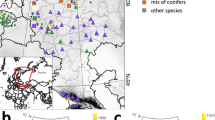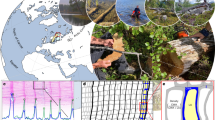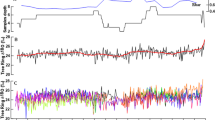Abstract
Descriptions of ice conditions, ranging from lake and sea ice to glacial advances and retreats, form an important portion of the climatic record. Ice formation, deterioration and changing areal extent are of increasing interest in climatology, sea transportation, petroleum exploration and the fishing industry. With few exceptions, quantitative information on ice conditions is generally brief, with many records in the US and Canada beginning only in the 1950s1. Tree-ring data from long-lived trees can be used as quantitative proxy data for past climatically related parameters. The record of first complete freezing of the Churchill River estuary on Hudson Bay is reconstructed here for 298 yr (1680-1977) by means of tree-ring analysis.
This is a preview of subscription content, access via your institution
Access options
Subscribe to this journal
Receive 51 print issues and online access
$199.00 per year
only $3.90 per issue
Buy this article
- Purchase on Springer Link
- Instant access to full article PDF
Prices may be subject to local taxes which are calculated during checkout
Similar content being viewed by others
References
Singh, B. Break-up and Freeze-up Dates: A Case Study of Inconsistencies in Climatological Data (University of Manitoba, Winnipeg, 1973).
Jacoby, G. C. & Cook, E. R. Arctic Alpine Res. 13, 409–418 (1981).
Garfinkel, H. L. & Brubaker, L. B. Nature 286, 872–874 (1980).
Cropper, J. P. & Fritts, H. C. Arctic Alpine Res. 13, 245–260 (1981).
Rogers, J. C. Mon. Weath. Rev. 106, 890–897 (1978).
Cook, E. R. & Peters, K. Tree-Ring Bull. 41, 45–53 (1981).
Fritts, H. C. Tree Rings and Climate (Academic, New York, 1976).
Moodie, D. W. & Catchpole, A. J. W. Environmental Data from Historical Documents by Content Analysis (University of Manitoba, Winnipeg, 1975).
Allen, W. T. R. Freeze-up, Break-up and Ice Thickness in Canada (Atmospheric Environment (AE)/Canada, Downsview, Ontario, 1977).
Siegel, S. Nonparametric Statistics for the Behavioral Sciences (McGraw-Hill, New York, 1956).
Mitchell, J. M. Jr et al. Climatic Change (World Meterological Organisation, Geneva, 1966).
Fritts, H. C. Reconstruction of Past Climatic Variability (University of Arizona, Tucson, 1976).
Neter, J. & Wasserman, W. Applied Linear Statistical Models (Irvin, Homewood, 1974).
Gordon, G. A. & LeDuc, S. K. Proc. Conf. on Probability and Statistics in Atmospheric Science, Monterey (1981).
Lamb, H. H. & Mörth, H. T. Geogr. J. 144, 1–22 (1978).
Kukla, G. & Gavin, J. Science 214, 497–503 (1981).
Hansen, et al. Science 213, 957–967 (1981).
Blasing, T. J. & Fritts, H. C. Climate of the Arctic/Proceedings Univ. Alaska 24th Alaska Science Conf. (1975).
Barnett, T. P. Mon. Weath. Rev. 106, 1353–1367 (1978).
Peters, K., Jacoby, G. C. & Cook, E. R. Tree-Ring Bull. 41, 1–19 (1981).
Author information
Authors and Affiliations
Rights and permissions
About this article
Cite this article
Jacoby, G., Ulan, L. Reconstruction of past ice conditions in a Hudson Bay estuary using tree rings. Nature 298, 637–639 (1982). https://doi.org/10.1038/298637a0
Received:
Accepted:
Issue Date:
DOI: https://doi.org/10.1038/298637a0
This article is cited by
-
Reconstructed changes in Arctic sea ice over the past 1,450 years
Nature (2011)
-
Secular trends in high northern latitude temperature reconstructions based on tree rings
Climatic Change (1993)
-
Reconstructed Northern Hemisphere annual temperature since 1671 based on high-latitude tree-ring data from North America
Climatic Change (1989)
Comments
By submitting a comment you agree to abide by our Terms and Community Guidelines. If you find something abusive or that does not comply with our terms or guidelines please flag it as inappropriate.



